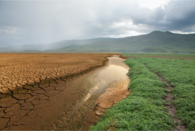Topic 5 "Landscapes of the Future – Preserving Terrestrial Ecosystems, Freshwater Resources, under Natural Dynamics and Global Change"│ GFZ-Participation

Landscapes have to meet a wide variety of demands: They should provide fresh water, food and habitats, but also be functioning ecosystems with intact biodiversity. Our research aims to show ways in which multifunctional landscapes can exist in a balance of human influence and natural dynamics - despite population growth and resource hunger. To this end, we are developing field experiments, observation networks and prediction models of the latest generation.
In the face of rapid global environmental and climatic change and its impacts, there is an urgent need to distinguish between natural mechanisms and human-induced processes. Further, understanding of the causes and effects of extreme events and their space-time dynamics is a prerequisite for their predictability. Together with partners at the Helmholtz Centres UFZ, AWI and hereon we study in Topic 5 processes linking the geosphere, atmosphere and biosphere and determine the natural dynamics of the terrestrial surface system and what the principle limits for the stability of this system are. Also impacts of extremes on natural and anthropogenic systems are the focus of our research. To achieve this, we aim to elucidate the behaviour of the system as a whole across all timescales of climate and environmental change by combining methods from geodesy, remote sensing, geology, geomorphology, geophysics, organic and inorganic geochemistry, hydrology, meteorology, ecology, (palaeo-)genetics and geomicrobiology.
The goals of our research are:
- to describe the natural dynamics of the Earth's surface in geologically recent warm periods and the effects of past climate changes on the Earth's surface system
- to document how forcing by tectonics, climate, ecosystems and human activity affect the shape of the Earth's surface, and to inversely determine how the shape of the Earth's surface records those effects
- to determine how natural climate and climate variability are reflected in lake sediments and tree rings, as well as in microbial features, weathering and erosion, and what climate feedbacks exist
- to clarify the relationships between tectonics, physical erosion, chemical weathering and microbial activity and their implications for the distribution of microbial life and the transfer and fluxes of sediment, carbon and nutrients across the Earth’s surface
- to explain trends and variability Earth-atmosphere exchange of trace gases and to determine their impacts on climate
- to determine the natural and human drivers of the storage, flow and release of water from catchments and aquifer systems and to quantify these dynamics with innovative satellite-based and in-situ observation techniques and simulation models
- to quantify the space-time patterns of hydrologic extremes and their impact on society as well as to project their dynamics under global change
Further information: Link to T5│Helmholtz-Zentrum für Umweltforschung UFZ





